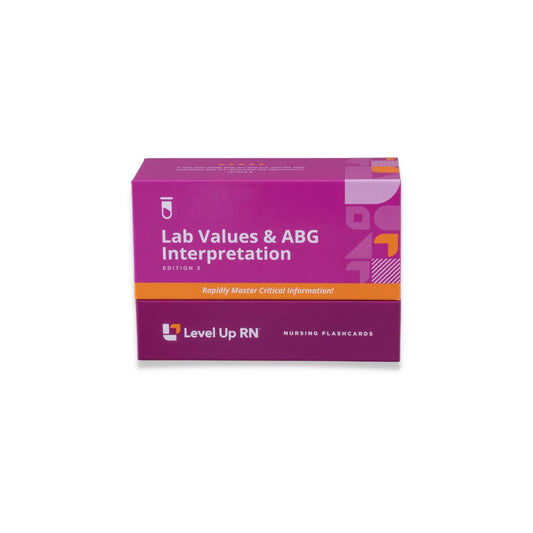Lab Values, part 6: Phosphorus (P)
The lab value phosphorus, including its function in the body, the expected range, and possible causes and symptoms of hypophosphatemia and hyperphosphatemia.
Quiz Questions
The nurse is caring for a patient who reports having alcohol use disorder and poor nutritional intake. Which phosphorus imbalance should the nurse anticipate?
The nurse is caring for a patient who reports having alcohol use disorder and poor nutritional intake. Which phosphorus imbalance should the nurse anticipate?
When caring for a patient with a positive Chvostek's and Trousseau sign, which phosphorus imbalance should the nurse anticipate?
When caring for a patient with a positive Chvostek's and Trousseau sign, which phosphorus imbalance should the nurse anticipate?
Full Transcript: Lab Values, part 6: Phosphorus (P)
Full Transcript: Lab Values, part 6: Phosphorus (P)
Hi, I'm Meris, and in this video, I'm going to be talking to you today about the lab value phosphorus. I'm going to be following along using our lab value flashcards. These are available on our website, leveluprn.com, if you want to grab a set for yourself, or if you are more of a fan of digital products. I would invite you to check out Flashables, the digital version of all of our flashcards, available on demand, and at your fingertips wherever you go. All right, let's go ahead and get started. So first up, let's talk about what phosphorus is and what its function is in our body. Phosphorus is an electrolyte. It is very important for bone and teeth formation. It's also important for metabolism and metabolic functions, and also, for protein synthesis. So if you think about that, how it's related to protein and metabolism, that can give you some information about things that might be at play when we are higher or lower on our phosphorus levels. Now, what is the expected range for phosphorus? Phosphorus is going to be 3.0 to 4.5 mg/dL. Again, that is a pretty narrow window there of a normal value. And so when you have a narrow value like that, it can be kind of difficult to remember. But we do have a Cool Chicken hint for you here to help you remember, which is, phos4us is normally around 4 mg/dL. So that just helps you to kind of remember that you are in that 4 range for phos4us.
So before we talk about hypophosphatemia and hyperphosphatemia, one of the things that I want to mention to you is that, phosphorus has an inverse relationship with calcium. And what this means is that they sit on different sides of a seesaw here. On one side, we have calcium, and on the other, we have phosphorus. They cannot both be up at the same time or down at the same time. When calcium is down, phosphorus is going to be elevated. And when calcium is elevated, phosphorus is going to be low. So this can also help you to remember some of the possible symptoms associated with high or low phosphorus because it's going to be related to some findings of high or low calcium as well, just in the opposite direction. Okay? So first, let's talk about hypophosphatemia. Here we are talking about a phosphorus level that is below 3.0 mg/dL. Now, when we are talking about the different causes of hypophosphatemia, remember, I told you that this is related a lot to protein synthesis and metabolism. And you know who has a problem with protein is going to be patients with alcoholism, alcohol use disorder. We're going to have a hard time with our protein there. And so I always think of this as being related to hypophosphatemia. Now we can also see this related to excess antacid, especially if those antacids are high in calcium, such as calcium carbonate. Again, remember, as calcium goes up, phosphorus is going to come down. And then malnutrition. Somebody who is malnourished may not have an appropriate amount of protein and may struggle to create the proteins needed inside the body. So I always think of this as being related to hypophosphatemia due to that protein link.
Now, what are some symptoms of hypophosphatemia? Well, because of that inverse relationship there with calcium, they're going to be the same as hypercalcemia. So when calcium is high and phosphorus is low, we're going to see things like, bone pain, we might have some muscle weakness, we might have GI upset, confusion, kidney stones. Lots of different things that can be going on, just refer back to those hypercalcemia findings.
Now, what about when we are talking about hyperphosphatemia? This is a phosphate level that is greater than 4.5 mg/dL. Well, some causes here, a big one, is going to be kidney disease. Your patients with kidney disease are at high risk for hyperphosphatemia, and when I have a patient that has kidney disease, this is one of those few times that I'm thinking specifically about phosphorus as an electrolyte on its own. Some possible symptoms associated with hyperphosphatemia are going to be similar to the ones associated with hypocalcemia. So we might have a positive Chvostek's or Trousseau's sign, and we may also have muscle spasms here and numbness and tingling, especially around the mouth.
All right, I'm so glad you stayed until the end because I'm going to test your knowledge of key facts provided in this video with some quiz questions.
When caring for a patient with a positive Chvostek's and Trousseau sign, which phosphorus imbalance should the nurse anticipate?
Hyperphosphatemia.
The nurse is caring for a patient who reports having alcohol use disorder and poor nutritional intake. Which phosphorus imbalance should the nurse anticipate?
Hypophosphatemia.
All right, that is it for this video. I do hope you found it helpful, and you learned something. All right, I'll see you in the next one. Thanks so much and happy studying.


